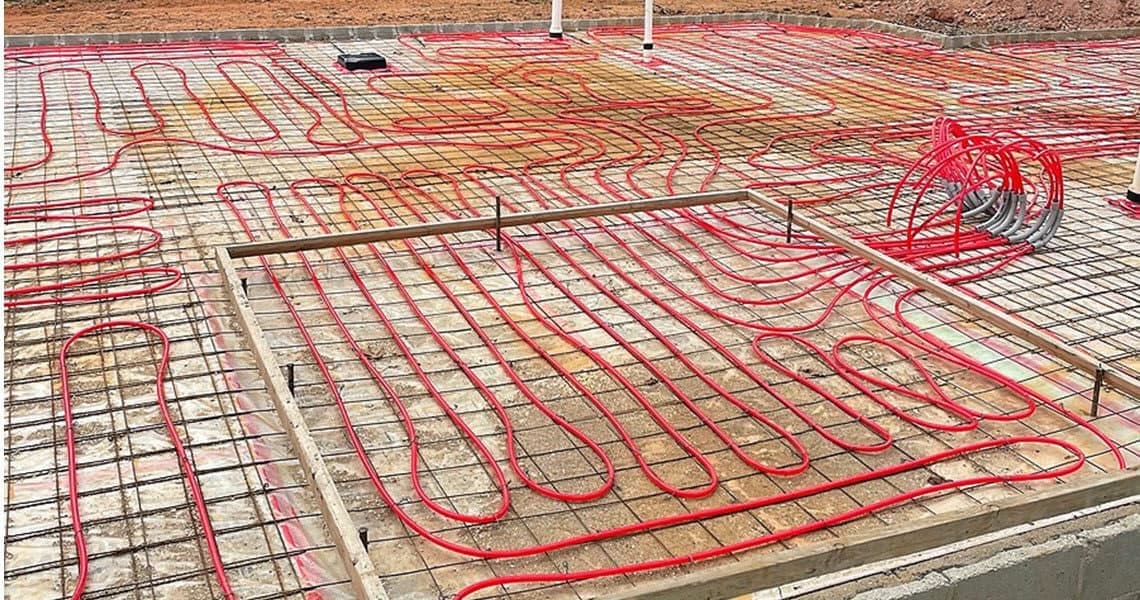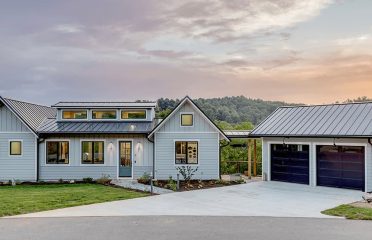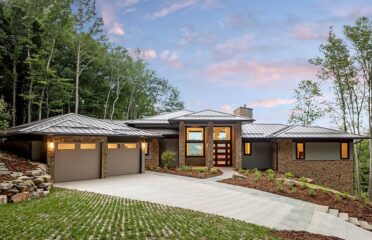A Guide to Radiant Floor Heating Systems
As more people look to build energy-efficient green homes, radiant in-floor heat is becoming more popular as a main source of heat and as a supplemental heat option. With radiant in-floor heat, you can keep each room at an ideal temperature and feel warm and comfy the moment you walk into a room.
Since more of our clients are selecting radiant in-floor heat for their custom homes, we put together this handy guide as part of our green building series to provide a solid overview of what it is, how it works, the benefits, and things to think about if you’re considering using it in your new home or as part of your renovation project.
What is Radiant In-Floor Heat?
Have you ever walked into a bathroom at someone’s house and noticed how lovely the warm tile felt against your feet? Because we all know how uncomfortable cold tiles are, right? That’s radiant in-floor heat. The radiant in-floor heat system heats the floor and the heat from the warm floor radiates up and disperses throughout the room. It’s different from an HVAC system that heats air and then uses a blower to force hot air into a room through a vent.
Most clients chose between an electronic or a hydronic system for their radiant in-floor heat, and both systems are pretty high tech.
Types of Radiant In-Floor Heat
The most popular radiant in-floor heat systems are hydronic, which uses water, and electronic, which uses heating wires.
Hydronic Radiant In-Floor Heat Systems
When you think of the word hydro, do you automatically connect water? If so, then you’re on the right track. Hydronic radiant in-floor heat systems push hot water through tubing under the floor. The heat from the water is transferred to conductive materials surrounding it, allowing the heat to warm the floor evenly and rise into the room. The tubing is connected to a boiler that pumps the hot water through the tubing that is laid out in a pattern in the subfloor in such a way that the whole floor is heated.
Hydronic systems are cost-effective over the long term, and in general, they cost less to operate than an electronic system. That said, hydronic systems can cost more up front because installation is more involved, yet they often pay for themselves over time with their efficiency.
If you’re considering a radiant in-floor system, hydronic systems are generally best to install when building a custom home. If you’re renovating a home and want to use hydronic in-floor heat, you must make water access, the pump and equipment, and the space part of the equation during the design process. Like HVAC systems, hydronic systems require regular maintenance.
Electronic Radiant In-Floor Heat Systems
An electronic radiant in-floor heat system uses electric heating wires to heat the floors. Connected to a power source, the heating wires are laid out in a pattern in the subfloor, and work in the same way hydronic systems work by transferring heat from the wires to conductive materials that evenly heat the floors.
If you’re renovating your home and want to install radiant in-floor heat in your bathroom, an electric system may be your best option. Installation is generally quick and occurs in between removing the old floor and laying your new one. Electric systems are energy efficient, cost-effective, and typically require little if any ongoing maintenance.
Benefits of Using Radiant In-Floor Heat Systems
We love a good list, and we can list many benefits for using a radiant in-floor heat system beyond no one liking a cold bathroom floor. Wink. Wink.
- They’re Invisible!
Unlike other heating options, in-floor heat systems are essentially invisible. Aside from the temperature controller, you don’t see them. Interior designers love them because they don’t have to design around floor or wall registers, returns, wall units, and the like. - Energy and Cost Savings!
A radiant in-floor heating system only needs to heat up to about 84 degrees Fahrenheit in order to warm a room. Since the floors are heated directly and the heat rises into the room, there’s no energy (heat) loss. Heating systems that rely on ductwork almost always lose energy (heat). Because they’re directly heating the floors, they’re more efficient to operate and can help drive down your electric bill when compared to an HVAC system. Many systems allow you to designate a temperature for each room. Meaning, if it’s a room you only use occasionally, why heat it to a cozy 70 degrees all the time? - They’re Smart
Most radiant in-floor heat thermostats are either smart or can connect to a smart thermostat, which makes it easy for you to program a heating schedule and designate temperatures for each room. Some systems even work with Google and Alexa, so you can control the temperature with just your voice. Hey Alexa! Set the primary bathroom heat to 72 degrees. Please. - Low to No Maintenance
Electronic in-floor heating systems require little if any maintenance, which makes them a great worry-free option. Hydronic in-floor heating systems are fairly low maintenance in that they only require periodic servicing. - Any Type of Flooring Works
In our experience and to our knowledge, radiant in-floor heating systems work with any type of floor you may choose. So, say yes to tile, wood, concrete, carpet, cork, laminate – it all works! - Clean Air
A great benefit of using radiant in-floor heat is improved indoor air quality. Forced air systems blow air around, which also blows around dust and other particulate (think allergens) that you ultimately inhale. When you use radiant heat, you don’t have that or indoor air pollutants that are the byproduct of gas- or oil-burning heating systems. If healthy air is an important consideration for your custom home, then radiant in-floor heat may be a good idea.
Now, is installing a radiant in-floor heat system a DYI project? Generally, not. We’d advise you to hire a professional. If you’re handy and are competent in working with electricity, then installing an electronic radiant in-floor heat system yourself is possible. Hydronic systems are significantly more involved and are best left to the experts.
More about Green Building
We have a library of articles dedicated to building green homes for you to peruse.
- Learn ways to reduce your carbon footprint on our blog.
- Read more about our experience as Asheville green builders on our About page.
- Find your green comfort zone here.
When you’re ready to build a custom home or commercial project that will reduce your energy costs, we’d love to talk. Click the button below to contact us.







